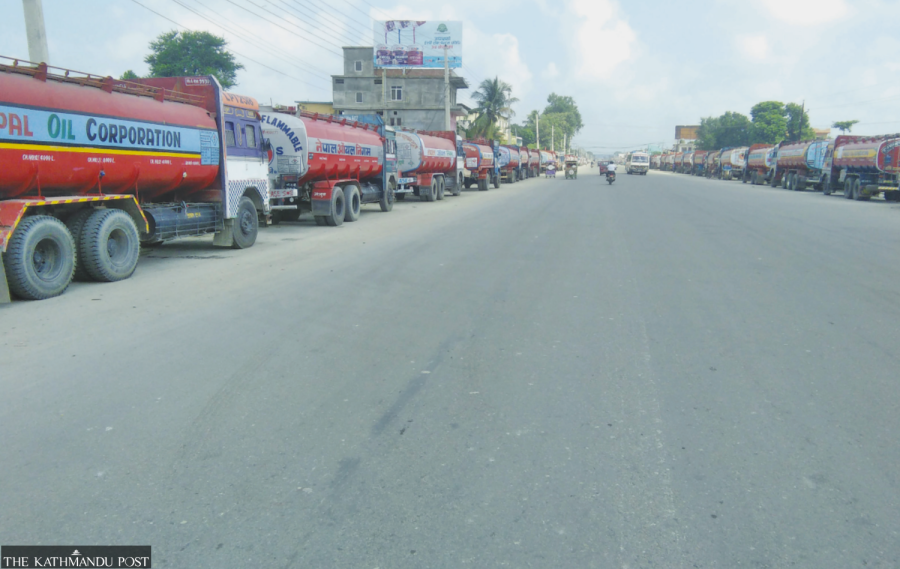Money
Oil import bill down by Rs15.36 billion. But there is little to cheer about
Nepal’s trade declined by 1.33 percent to Rs1.74 trillion, or by Rs23.50 billion, in 2023-2024.
Sangam Prasain
Nepal’s petroleum imports dropped by 4.35 percent to Rs337.34 billion in the last fiscal year ended July 15, due to lower international rates. Official data showed that the country continues to be dependent on fossil fuel despite the surge in electric vehicles (EVs) and more electricity generation.
The imports of three oil products—diesel, kerosene, and liquified petroleum gas—have dropped by Rs15.36 billion combined, mainly in terms of value.
A breakdown of the oil import bills shows diesel imports dropped by 6.36 percent to Rs143.97 billion, which translates to a decrease of Rs9.79 billion. However, in terms of quantity, Nepal imported 1.41 million kilolitres of diesel in the last fiscal year, a marginal drop of 2,946 kilolitres compared to the previous fiscal year's imports. (1 kilolitre = 1,000 litres).
Similarly, petrol imports in terms of value dropped by Rs1.25 billion to Rs68.1 billion in the last fiscal year. But in terms of quantity, imports increased by 7,124 kilolitres to 687,931 kilolitres.
Likewise, imports of liquified petroleum gas, popularly known as cooking gas, dropped by Rs2.53 billion to Rs55.61 billion. But the quantity of imports increased by 9,863 tonnes to 524,204 tonnes.
“From no angle can we say that the rise in electricity generation and adoption of EVs have cut down on petroleum consumption,” said Manoj Kumar Thakur, spokesperson of Nepal Oil Corporation.
“Petroleum prices jumped because of the Russia-Ukraine war that started in February 2022,” he said.
Due to the price factor, the oil monopoly had to curtail imports in the previous fiscal year, and this was visible in the reduced imports.
Thakur said that the petrol price, which had reached Rs190 per litre two years ago, has now come down to Rs171 per litre.
According to a recent economic survey, Nepal is gradually moving toward becoming energy self-sufficient.
As of mid-March, 97.7 percent of the population had access to electricity, while the country’s total electricity output had reached 3,060 MW. Since 2021, the country started producing surplus power, especially in the wet season. Nepal began exporting power to India in November 2021.
Between June 1 and December 6, 2023, Nepal sold electricity worth Rs15.4 billion to India.
Analysts say that despite being a clean energy surplus, the use of fossil fuels that produce hazardous air pollutants, including sulphur dioxide, nitrogen oxides, particulate matter, and carbon monoxide, have been rising.
According to the Department of Customs, imports of electric vehicles (EVs) jumped to Rs30.77 billion in the last fiscal year from Rs12.60 billion in the previous fiscal year. Despite the dramatic growth in EV imports, imports of fossil fuel, however, have been rising.
Thakur said that though EV imports are rising, the demand for combustion vehicles that burn fossil fuels has remained strong.
“Petrol imports will decrease if EVs are imported for mass transport.”
However, the drop in petroleum, fertiliser, and cereal imports has reduced Nepal’s overall international trade, which has dropped for the second consecutive year after peaking in 2022.
Nepal’s trade, combined imports and exports, dropped by 1.33 percent to Rs1.74 trillion in the fiscal year 2023-2024, or Rs23.50 billion.
According to analysts, the downturn reflects a slowdown in economic activities.
The downturn was driven by a fall in imports, which dropped by 1.16 percent to Rs1.59 trillion, translating to a decrease of Rs18.74 billion. The country’s exports, too, fell by 3.03 percent to Rs152.38 billion, a reduction of Rs4.75 billion in the review period.
Trade experts said Nepal’s attempt to save foreign exchange by strangling imports nearly suffocated the economy in the previous fiscal year.
Worried by rapidly receding foreign currency reserves and growing trade imbalance, the government in April 2022 banned the import of a slew of luxury goods.
The embargo, which lasted till December 2022, worked all too well. It had the desired effect of squeezing the bloated trade deficit, but it also caused the economy to slow down dangerously to a near stall.
Trade experts said the ad hoc decision to slam the brakes on imports put the country into total disarray in the previous fiscal year. The annual growth rate sank to a new low, and Nepal plunged into its first recession in six decades in the first two quarters.
Nepal’s foreign trade shrank by 16.58 percent to Rs1.76 trillion in the previous fiscal year. Imports fell by 16.08 percent to Rs1.61 trillion, while exports dropped by 21.44 percent to Rs157 billion.
An official at the National Statistics Office said that as Nepal is now an import-driven economy, any contraction in trade activities will hurt the economy.
A country’s import and export activities can influence its GDP.
When a country imports goods, it represents an outflow of funds.
“A high level of imports, mainly productive assets, such as machinery and equipment, indicates robust domestic demand and a growing economy,” said Hem Raj Regmi, deputy chief statistician at the National Statistics Office.
“Importing industrial machines is more favourable for a country since productive assets will improve the economy’s productivity over the long run. But the statistics show a drop in the import of industrial machinery, which is worrisome.”
“But there is something to cheer about. The import of petrol and diesel, Nepal's top import commodities, has dropped,” said Regmi. Cereal imports dropped to Rs45.79 billion from Rs56.62 billion due to India's ban. However, industry insiders say the prohibition was costly for Nepalis, as food prices jumped significantly in the last fiscal year.




 6.12°C Kathmandu
6.12°C Kathmandu















